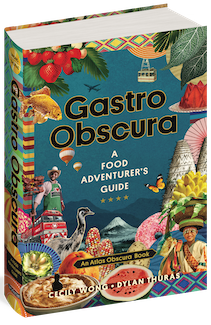AO Edited
Gastro Obscura
Casa Madero
This grape-growing paradise is one of the oldest vineyards in North America.
Only vines grown in the toughest soil conditions produce the best grapes; their roots have to fight for every last drop of water year after year. Likewise, the wine estate, now known as Casa Madero, has for over four centuries continually adapted, making it one of North America’s oldest vineyards.
The story began in 1567 when the Spanish arrived in the Parras Valley looking for gold; instead, they found an abundance of wild vines and fresh springs. A couple of decades later in 1594, the Jesuits, who had a long history in viticulture in Europe, arrived and produced the first wine in the region. And just a year later , Spanish conquistadors established Hacienda San Lorenzo as a Jesuit mission. These monks, first the Jesuits and then the Franciscans, established the winery at the mission.
In 1777, a visit from Fray Agustín de Morfi, an illustrious Franciscan historian, attested to their success “… The cellar occupies the ground floor of the house, we find it well provided with wine and brandy, which is distilled for ten stills. Don Antonio Esparza, its administrator, assured us that there is a score of about 3 million plants, well equipped with water because there are abundant eyes of water and 1,000 arrobas of wine and 700 of brandy benefit from there.
However, the strong relationship between the Spanish and the Jesuits that enabled the success of the winery started to deteriorate, and in 1767 the King of Spain ordered the expulsion of the Jesuits. After it was abandoned, the site fell into disrepair.
Fortunately, the Madero family saw the potential in the winery, bought the estate in 1893 and brought the production back to its former glory. They salvaged the infrastructure the monks left behind. This included rebuilding the winery’s production amongst the former monastery and revitalizing the basement of barrels. Furthermore, they restored the church, that the monks built, which is a central focus at Casa Madero.
The vineyard faced a number of challenges still. In the late 1800s, an outbreak of the phylloxera parasite devastated the vineyard. The Maderos adopted a grafting technique, implanting a European grapevine into the roots of an American plant, thereby circumventing the parasite’s attack.
Just like the ramifying roots of the grapevine in search of minerals in dry soils; the vineyard winery has likewise found ways to “branch out” to adapt, survive and thrive. Today, the vineyard is proud of its centuries-old roots and fine wines.
Know Before You Go
A guided tour of the vineyard and winery costs roughly 1000 pesos. You book in advance or turn up on the day, and hope that there are still places. The tour includes wine tasting.
Plan Your Trip
The Atlas Obscura Podcast is Back!






















Follow us on Twitter to get the latest on the world's hidden wonders.
Like us on Facebook to get the latest on the world's hidden wonders.
Follow us on Twitter Like us on Facebook